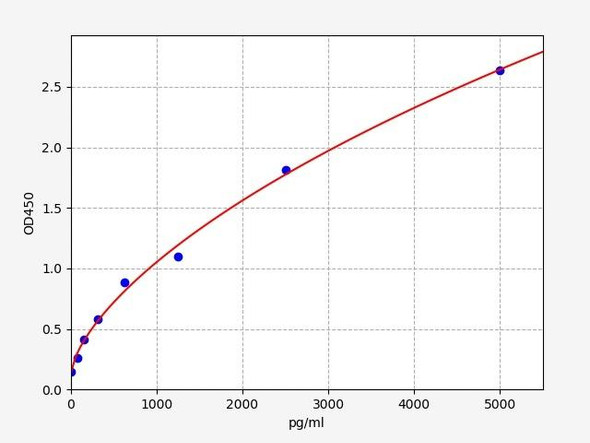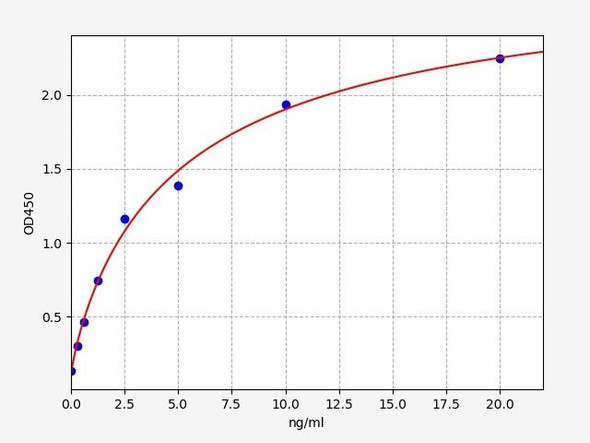Human Daxx ELISA Kit
- SKU:
- HUFI02383
- Product Type:
- ELISA Kit
- Size:
- 96 Assays
- Uniprot:
- Q9UER7
- Sensitivity:
- 37.5pg/ml
- Range:
- 62.5-4000pg/ml
- ELISA Type:
- Sandwich ELISA, Double Antibody
- Synonyms:
- DAP6, BING2, BING2, CENP-C binding protein, DAP6MGC126245, Daxx, death domain-associated protein 6, death-associated protein 6, death-domain associated protein, EAP1, ETS1-associated protein 1, Fas death domain-associated protein, Fas-binding protein
- Reactivity:
- Human
Description
| Product Name: | Human Daxx ELISA Kit |
| Product Code: | HUFI02383 |
| Size: | 96 Assays |
| Alias: | DAP6, BING2, BING2, CENP-C binding protein, DAP6MGC126245, Daxx, death domain-associated protein 6, death-associated protein 6, death-domain associated protein, EAP1, ETS1-associated protein 1, Fas death domain-associated protein, Fas-binding protein, hDaxx |
| Detection method: | Sandwich ELISA, Double Antibody |
| Application: | This immunoassay kit allows for the in vitro quantitative determination of Human DAP6 concentrations in serum plasma and other biological fluids. |
| Sensitivity: | 37.5pg/ml |
| Range: | 62.5-4000pg/ml |
| Storage: | 4°C for 6 months |
| Note: | For Research Use Only |
| Recovery: | Matrices listed below were spiked with certain level of Human DAP6 and the recovery rates were calculated by comparing the measured value to the expected amount of Human DAP6 in samples. | ||||||||||||||||
| |||||||||||||||||
| Linearity: | The linearity of the kit was assayed by testing samples spiked with appropriate concentration of Human DAP6 and their serial dilutions. The results were demonstrated by the percentage of calculated concentration to the expected. | ||||||||||||||||
| |||||||||||||||||
| CV(%): | Intra-Assay: CV<8% Inter-Assay: CV<10% |
| Component | Quantity | Storage |
| ELISA Microplate (Dismountable) | 8×12 strips | 4°C for 6 months |
| Lyophilized Standard | 2 | 4°C/-20°C |
| Sample/Standard Dilution Buffer | 20ml | 4°C |
| Biotin-labeled Antibody(Concentrated) | 120ul | 4°C (Protect from light) |
| Antibody Dilution Buffer | 10ml | 4°C |
| HRP-Streptavidin Conjugate(SABC) | 120ul | 4°C (Protect from light) |
| SABC Dilution Buffer | 10ml | 4°C |
| TMB Substrate | 10ml | 4°C (Protect from light) |
| Stop Solution | 10ml | 4°C |
| Wash Buffer(25X) | 30ml | 4°C |
| Plate Sealer | 5 | - |
Other materials and equipment required:
- Microplate reader with 450 nm wavelength filter
- Multichannel Pipette, Pipette, microcentrifuge tubes and disposable pipette tips
- Incubator
- Deionized or distilled water
- Absorbent paper
- Buffer resevoir
| Uniprot | Q9UER7 |
| UniProt Protein Function: | DAXX: a transcriptional co-regulatory protein. Proposed to mediate activation of the JNK pathway and apoptosis via ASK1 in response to signaling from FAS and TGF-betaR2. Glucose deprivation activates the ASK1-SEK1-JNK1-HIPK1 pathway, relocalizing Daxx from the nucleus to the cytoplasm, where Daxx binds to ASK1, and subsequently leads to ASK1 oligomerization. Interaction with HSP27 may prevent interaction with TGF-betaR2 and ASK1 and block DAXX-mediated apoptosis. Seems to act as a transcriptional co- repressor and inhibits PAX3 and ETS1 through direct protein- protein interaction. Its transcription repressor activity is modulated by recruiting it to subnuclear compartments like the nucleolus or PML/POD/ND10 nuclear bodies through interactions with MCSR1 and PML, respectively. Two alternatively spliced isoforms have been described. |
| UniProt Protein Details: | Protein type:Nucleolus; Nuclear receptor co-regulator; Transcription, coactivator/corepressor; Apoptosis Chromosomal Location of Human Ortholog: 6p21.3 Cellular Component: chromosome, pericentric region; cytoplasm; cytosol; nucleoplasm; nucleus; PML body Molecular Function:androgen receptor binding; enzyme binding; heat shock protein binding; histone binding; p53 binding; protein binding; protein kinase activator activity; protein kinase binding; protein N-terminus binding; receptor signaling protein activity; transcription corepressor activity; ubiquitin protein ligase binding Biological Process: activation of JNK activity; androgen receptor signaling pathway; apoptosis; chromatin remodeling; induction of apoptosis via death domain receptors; negative regulation of transcription, DNA-dependent; nucleosome assembly; positive regulation of protein amino acid phosphorylation; positive regulation of protein kinase activity; regulation of protein ubiquitination; regulation of transcription, DNA-dependent |
| NCBI Summary: | This gene encodes a multifunctional protein that resides in multiple locations in the nucleus and in the cytoplasm. It interacts with a wide variety of proteins, such as apoptosis antigen Fas, centromere protein C, and transcription factor erythroblastosis virus E26 oncogene homolog 1. In the nucleus, the encoded protein functions as a potent transcription repressor that binds to sumoylated transcription factors. Its repression can be relieved by the sequestration of this protein into promyelocytic leukemia nuclear bodies or nucleoli. This protein also associates with centromeres in G2 phase. In the cytoplasm, the encoded protein may function to regulate apoptosis. The subcellular localization and function of this protein are modulated by post-translational modifications, including sumoylation, phosphorylation and polyubiquitination. Alternative splicing results in multiple transcript variants. [provided by RefSeq, Nov 2008] |
| UniProt Code: | Q9UER7 |
| NCBI GenInfo Identifier: | 24636785 |
| NCBI Gene ID: | 1616 |
| NCBI Accession: | Q9UER7.2 |
| UniProt Secondary Accession: | Q9UER7,O14747, O15141, O15208, Q5STK9, Q9BWI3, B4E1I3 F5ANJ6, F5ANJ7, F5H082, |
| UniProt Related Accession: | Q9UER7 |
| Molecular Weight: | 75,563 Da |
| NCBI Full Name: | Death domain-associated protein 6 |
| NCBI Synonym Full Names: | death domain associated protein |
| NCBI Official Symbol: | DAXX |
| NCBI Official Synonym Symbols: | DAP6; EAP1; BING2 |
| NCBI Protein Information: | death domain-associated protein 6 |
| UniProt Protein Name: | Death domain-associated protein 6 |
| UniProt Synonym Protein Names: | Daxx; hDaxx; ETS1-associated protein 1; EAP1; Fas death domain-associated protein |
| Protein Family: | Death domain-associated protein |
| UniProt Gene Name: | DAXX |
| UniProt Entry Name: | DAXX_HUMAN |
*Note: Protocols are specific to each batch/lot. For the correct instructions please follow the protocol included in your kit.
Before adding to wells, equilibrate the SABC working solution and TMB substrate for at least 30 min at 37°C. When diluting samples and reagents, they must be mixed completely and evenly. It is recommended to plot a standard curve for each test.
| Step | Protocol |
| 1. | Set standard, test sample and control (zero) wells on the pre-coated plate respectively, and then, record their positions. It is recommended to measure each standard and sample in duplicate. Wash plate 2 times before adding standard, sample and control (zero) wells! |
| 2. | Aliquot 0.1ml standard solutions into the standard wells. |
| 3. | Add 0.1 ml of Sample / Standard dilution buffer into the control (zero) well. |
| 4. | Add 0.1 ml of properly diluted sample ( Human serum, plasma, tissue homogenates and other biological fluids.) into test sample wells. |
| 5. | Seal the plate with a cover and incubate at 37 °C for 90 min. |
| 6. | Remove the cover and discard the plate content, clap the plate on the absorbent filter papers or other absorbent material. Do NOT let the wells completely dry at any time. Wash plate X2. |
| 7. | Add 0.1 ml of Biotin- detection antibody working solution into the above wells (standard, test sample & zero wells). Add the solution at the bottom of each well without touching the side wall. |
| 8. | Seal the plate with a cover and incubate at 37°C for 60 min. |
| 9. | Remove the cover, and wash plate 3 times with Wash buffer. Let wash buffer rest in wells for 1 min between each wash. |
| 10. | Add 0.1 ml of SABC working solution into each well, cover the plate and incubate at 37°C for 30 min. |
| 11. | Remove the cover and wash plate 5 times with Wash buffer, and each time let the wash buffer stay in the wells for 1-2 min. |
| 12. | Add 90 µl of TMB substrate into each well, cover the plate and incubate at 37°C in dark within 10-20 min. (Note: This incubation time is for reference use only, the optimal time should be determined by end user.) And the shades of blue can be seen in the first 3-4 wells (with most concentrated standard solutions), the other wells show no obvious color. |
| 13. | Add 50 µl of Stop solution into each well and mix thoroughly. The color changes into yellow immediately. |
| 14. | Read the O.D. absorbance at 450 nm in a microplate reader immediately after adding the stop solution. |
When carrying out an ELISA assay it is important to prepare your samples in order to achieve the best possible results. Below we have a list of procedures for the preparation of samples for different sample types.
| Sample Type | Protocol |
| Serum | If using serum separator tubes, allow samples to clot for 30 minutes at room temperature. Centrifuge for 10 minutes at 1,000x g. Collect the serum fraction and assay promptly or aliquot and store the samples at -80°C. Avoid multiple freeze-thaw cycles. If serum separator tubes are not being used, allow samples to clot overnight at 2-8°C. Centrifuge for 10 minutes at 1,000x g. Remove serum and assay promptly or aliquot and store the samples at -80°C. Avoid multiple freeze-thaw cycles. |
| Plasma | Collect plasma using EDTA or heparin as an anticoagulant. Centrifuge samples at 4°C for 15 mins at 1000 × g within 30 mins of collection. Collect the plasma fraction and assay promptly or aliquot and store the samples at -80°C. Avoid multiple freeze-thaw cycles. Note: Over haemolysed samples are not suitable for use with this kit. |
| Urine & Cerebrospinal Fluid | Collect the urine (mid-stream) in a sterile container, centrifuge for 20 mins at 2000-3000 rpm. Remove supernatant and assay immediately. If any precipitation is detected, repeat the centrifugation step. A similar protocol can be used for cerebrospinal fluid. |
| Cell culture supernatant | Collect the cell culture media by pipette, followed by centrifugation at 4°C for 20 mins at 1500 rpm. Collect the clear supernatant and assay immediately. |
| Cell lysates | Solubilize cells in lysis buffer and allow to sit on ice for 30 minutes. Centrifuge tubes at 14,000 x g for 5 minutes to remove insoluble material. Aliquot the supernatant into a new tube and discard the remaining whole cell extract. Quantify total protein concentration using a total protein assay. Assay immediately or aliquot and store at ≤ -20 °C. |
| Tissue homogenates | The preparation of tissue homogenates will vary depending upon tissue type. Rinse tissue with 1X PBS to remove excess blood & homogenize in 20ml of 1X PBS (including protease inhibitors) and store overnight at ≤ -20°C. Two freeze-thaw cycles are required to break the cell membranes. To further disrupt the cell membranes you can sonicate the samples. Centrifuge homogenates for 5 mins at 5000xg. Remove the supernatant and assay immediately or aliquot and store at -20°C or -80°C. |
| Tissue lysates | Rinse tissue with PBS, cut into 1-2 mm pieces, and homogenize with a tissue homogenizer in PBS. Add an equal volume of RIPA buffer containing protease inhibitors and lyse tissues at room temperature for 30 minutes with gentle agitation. Centrifuge to remove debris. Quantify total protein concentration using a total protein assay. Assay immediately or aliquot and store at ≤ -20 °C. |
| Breast Milk | Collect milk samples and centrifuge at 10,000 x g for 60 min at 4°C. Aliquot the supernatant and assay. For long term use, store samples at -80°C. Minimize freeze/thaw cycles. |










